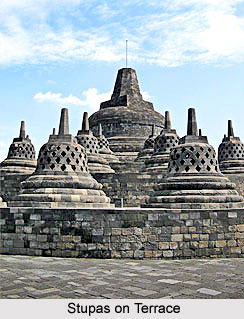 The stupas on terrace at Sanchi lie in one of the three well defined areas; the others being the Eastern Area and the Southern Area, all lying within an eleventh-twelfth century AD stone circuit-wall. The monuments of Sanchi, thus, may be divided into two groups, one comprising those situated on the hill-top and the other, the isolated ones on the Western Slope of the hill. The plateau on the top of the hill is oblong in shape and measures about 384 metres from north to south and 201 metres from east to west.
The stupas on terrace at Sanchi lie in one of the three well defined areas; the others being the Eastern Area and the Southern Area, all lying within an eleventh-twelfth century AD stone circuit-wall. The monuments of Sanchi, thus, may be divided into two groups, one comprising those situated on the hill-top and the other, the isolated ones on the Western Slope of the hill. The plateau on the top of the hill is oblong in shape and measures about 384 metres from north to south and 201 metres from east to west.
The gateway leading to the stupas to the terrace is slightly over 5 metres high. Its decoration and constituents are similar in subject and style to those of the gateways of Stupa 1, though the workmanship is definitely inferior. With the exception of the scene carved on the front side of the lowest architrave, which has been interpreted as the paradise of Indra (Nandana-vana), where Lord Indra is seated at the centre on a throne under a pavilion surrounded by attendants, the reliefs have their analogues on the gateways of Stupa 1.
The importance of this stupa lies in the fact that the relics of Sariputta and Maudgalyayana, the two foremost disciples of the Gautama Buddha, were found enshrined at the centre of its dome on the level of the terrace. Inside the relic-chamber, which was covered by a large stone slab of over 1.5 metres, were two stone boxes with their lids respectively inscribed with the words Sariputta and Maha-Mogalanasa.
Sariputta`s box contained a white steatite relic-casket, covered by a thin earthen saucer of lustrous blackware, along with two pieces of sandalwood. Inside the casket were found a small fragment of bone and seven beads, variously of pearl, garnet, lapis lazuli, crystal and amethyst. On the inner surface of the lid was written in ink the letter sa, the initial of Sariputtam. In Maudgalyayana`s box was found another casket, somewhat smaller, containing two small fragments of bone. The lid was initialled in ink with the letter ma.
Besides these two conspicuous stupas, there are the remains of a large number of other stupas on the main terrace around the north-east, south-east and south-west quadrants of the Great Stupa.
They are either monolithic or structural. The former, often with the relief of a Buddhist divinity, are portable. None of the masonry stupas, however, is intact, and most survive only up to their plinth.
Behind Stupa 3 is Stupa 4, ascribable to the second century BC, which exists only in a heap of loose stones without the trace of any ground balustrade. A coping stone, relieved with an undulating stem containing within its foils lotuses, buds, leaves and birds, was found near the stupa; it might have formed part of the balustrade around the harmika. Stupa 5, to the south of Stupa 3, is remarkable in its having an image of the Buddha in the dhyana mudra on a moulded pedestal built against its southern side. The stupa is built on a circular plinth with narrow courses of masonry and with footings; it is ascribable to about the sixth century AD. The two small stupas, 28 and 29, are to the east of Stupa 5. Both have high square bases with cornices and footings characteristic of the early Gupta age. Stupa 29 presents interesting features, not only in its having a core of large-sized bricks, but also in its having contained, within a small relic-chamber, a bone-relic along with the fragment of a highly-polished vase of the Maurya or Sunga age, placed in a cup of coarse ware with a second cup serving as the lid.
The size of the bricks and the presence of the early vase suggest that the relic was transferred here after the original stupa, which might have been of the Maurya period, had fallen to decay. The group constituted by Stupas 12, 13, 14 and 16, about 61 metres south of Stupa 5, is characterised by square plinths strengthened by footings; it belongs to the sixth-seventh century AD. The stupas are built of rubble and earth, faced with well-dressed courses of stone.
Some of them contain relic-chambers. In the fallen debris of Stupa 12, the relic-chamber of which had been completely destroyed before its excavation, was found the foot and pedestal fragment of an inscribed image of Maitreya. Another image, that of the Buddha in the dhyana-mudra, made of Mathura sandstone and belonging to the early Gupta period, was found against the western wall of the relic-chamber of Stupa 14.
Immediately to the south of this group is Stupa 6. Its core is built of heavy blocks of stone interspersed with chippings as in Stupas 3 and 4, with which Stupa 6 was contemporaneous. The existing facing both the superstructure and the plinth, the latter square on plan and provided with footings characteristic of the early medieva1 stupas of this site, dates from the seventh or eighth century AD. Stupa 7, about 30 metres to the south-west of the West Gate of Stupa 1, has the same structural features as Stupas 12, 13, 14 and 16. It rises to a height of 2.13 metres and is surrounded by the remains of a terrace, probably of a later date.



















